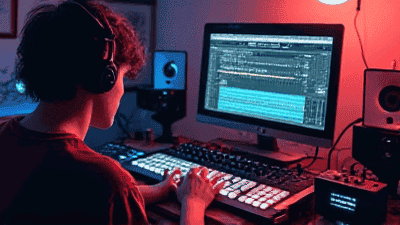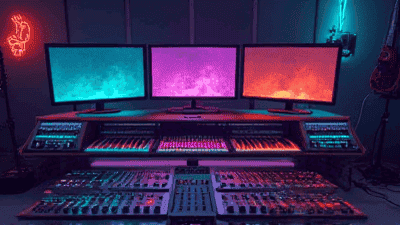
From Concept to Track: Essential Techniques for Mastering Music Production as a Beginner
Introduction

Music production, at its core, is the art and science of transforming abstract musical ideas into tangible sonic experiences. In today's digital landscape, the tools for creation are more accessible than ever, yet this accessibility often masks the intricate mechanisms and foundational principles required for crafting truly impactful sound. Many aspiring producers find themselves navigating a complex ecosystem of software and hardware, leading to a discussion about mastering the fundamentals.
The proliferation of Digital Audio Workstations (DAWs) has democratized music creation, empowering independent artists and established producers alike to develop high-quality tracks from virtually anywhere. This has profoundly impacted the music industry, shifting power dynamics and fostering unprecedented creative output. However, beneath the intuitive interfaces lie critical concepts such as audio engineering, synthesis, and mixing, which are indispensable for achieving professional results. Understanding these elements is paramount for navigating current developments in spatial audio, AI-driven composition, and the evolving sound design landscape. Without a deep comprehension of music production's core tenets, what impact would it have on our understanding or practice of creating meaningful and engaging audio experiences?
The Foundation of Sound
Digital Audio Workstations (DAWs) and Core Audio Principles
At the heart of modern music production lies the Digital Audio Workstation (DAW), a software application functioning as a comprehensive virtual studio. Programs like Ableton Live, Logic Pro X, and FL Studio provide the environment for recording, arranging, editing, mixing, and mastering audio. Understanding a DAW is akin to learning the layout of a physical recording studio, with its consoles, tape machines, and effects racks all integrated digitally. Crucially, producers must also grasp core audio principles such as sampling rate (the number of samples of audio carried per second, dictating frequency response up to half its value, e.g., 44.1 kHz for CD quality) and bit depth (the number of bits of information in each sample, influencing dynamic range and signal-to-noise ratio). Higher bit depth offers more headroom and detail, crucial for professional sound. These technical specifications directly impact the fidelity and quality of the final output. For instance, recording at 24-bit/48kHz provides a much wider dynamic range and clearer high-frequency capture than 16-bit/44.1kHz, offering more flexibility during mixing. Mastering these basics ensures that the sonic canvas upon which all creativity is built is robust and pristine.
Building Blocks of a Track

MIDI, Synthesis, and Drum Programming Essentials
Beyond simply recording audio, music production involves creating and manipulating musical data, primarily through MIDI (Musical Instrument Digital Interface). MIDI is not audio itself but rather a set of instructions—like a digital blueprint—telling virtual instruments (software instruments within your DAW) or hardware synthesizers what notes to play, how long to play them, how loud, and with what articulation. This allows for immense flexibility, as MIDI notes can be easily edited, transposed, or re-quantized (aligned to a rhythmic grid) without re-recording.
Synthesis is the process of generating sound using electronic circuits or software algorithms. A foundational method is subtractive synthesis, where an initial harmonically rich waveform (e.g., sawtooth, square) is "sculpted" by filters to remove specific frequencies and by amplifiers controlled by envelopes (ADSR: Attack, Decay, Sustain, Release) to shape its amplitude over time. Understanding ADSR is crucial for crafting sounds from sharp plucks to evolving pads.
Drum programming involves arranging rhythmic patterns using sampled drum sounds or synthesized percussion. Modern DAWs offer sophisticated drum racks and sequencers, allowing precise control over velocity, timing, and groove. Quantization tools help align individual drum hits to the beat, while micro-timing adjustments can introduce human-like imperfections for a more natural feel.
The choice of synthesis type significantly impacts the character of a sound, offering distinct sonic palettes for producers. The following table illustrates some common synthesis methods and their typical applications:
| Synthesis Type | Core Principle | Common Applications | Distinctive Trait |
|---|---|---|---|
| Subtractive | Filtering a rich waveform | Basslines, leads, pads | Warm, analog-like |
| FM (Frequency Modulation) | Modulating one oscillator's frequency with another | Bells, metallic sounds, percussive | Bright, digital, complex harmonics |
| Wavetable | Scanning through a collection of single-cycle waveforms | Evolving pads, morphing textures | Dynamic, futuristic |
For instance, FM synthesis, popularized by the Yamaha DX7, excels at creating sharp, bell-like tones or gritty basses, whereas subtractive synthesis is favored for its organic warmth in creating lead melodies and lush pads. Producers often blend these techniques, using a powerful bassline from a subtractive synth while adding shimmer with FM bells. Mastering these building blocks empowers producers to generate virtually any sound imaginable, from realistic instrument simulations to entirely novel sonic textures.
Polishing Your Mix
Introduction to Mixing and Basic Audio Effects
Mixing is the crucial stage where all individual elements of a track—drums, bass, melodies, vocals—are blended and balanced to create a cohesive and professional-sounding whole. The goal is to achieve clarity, ensuring each instrument occupies its own sonic space, balance, where no element is too loud or too soft, and depth/width, creating an immersive stereo image. Think of mixing as sculpting a block of raw marble into a refined statue; each stroke of the chisel (effect) helps define the form.
Key tools in a mixer's arsenal are Equalization (EQ), Compression, Reverb, and Delay. EQ is used to shape the frequency content of a sound, boosting desirable frequencies and cutting undesirable ones to make instruments fit together. For example, cutting low-mids from a guitar can make room for the bass guitar's fundamental frequencies. Compression reduces the dynamic range of a sound, making quiet parts louder and loud parts quieter, resulting in a more consistent and punchy signal. Reverb simulates the natural reflections of sound in a physical space, adding depth and ambience, making a dry vocal sound as if it's in a hall or a small room. Delay creates echoes, adding rhythmic texture and often perceived width. Judicious application of these effects, combined with careful volume and panning adjustments, transforms a collection of raw recordings into a polished and impactful song.
Conclusion

This handbook has explored the fundamental pillars of music production, guiding beginners through the journey from initial concept to a refined audio track. We began by defining the essential role of Digital Audio Workstations (DAWs) as the modern music studio, emphasizing the importance of understanding core audio principles like sampling rate and bit depth to ensure a high-fidelity foundation. We then delved into the creative heart of production, dissecting MIDI as the language of virtual instruments, demystifying sound synthesis—particularly subtractive and its ADSR envelope—and outlining effective drum programming techniques for rhythmic integrity. Finally, we unpacked the art of mixing, introducing key audio effects like EQ, compression, reverb, and delay, which are indispensable for achieving sonic clarity, balance, and depth. The synthesis of these elements forms the bedrock upon which aspiring producers can build their unique sonic vision, translating abstract musical ideas into tangible, professional-sounding compositions.
Looking ahead, the landscape of music production is poised for exciting and transformative shifts. We anticipate further integration of artificial intelligence in areas like generative music, intelligent mixing assistants, and adaptive sound design, which could accelerate workflow and open new creative avenues. However, these technological iterations will not diminish the value of a strong grasp of foundational principles; rather, they will underscore the need for producers to understand why certain decisions are made by AI and how to ethically integrate these tools. Challenges will include navigating the ethical implications of AI-generated content, protecting artistic originality, and adapting to ever-evolving software and hardware ecosystems. Continuous learning, experimentation, and a deep appreciation for the core mechanics of sound will remain paramount, ensuring that human creativity continues to drive the art of music production into its next innovative phase.
Frequently Asked Questions (FAQ)
Q: What DAW should a beginner choose, and what factors should influence this decision? A: Choosing the right Digital Audio Workstation (DAW) is a common challenge for beginners, as the market offers numerous powerful options. There isn't a single "best" DAW; the ideal choice depends on several factors, including your operating system, budget, preferred workflow, and musical genre. For Mac users, Logic Pro X is a highly popular and cost-effective option, offering a professional suite of tools and a vast sound library at a one-time purchase price. It’s known for its intuitive interface and strong audio recording capabilities. For cross-platform compatibility (Windows and Mac), Ableton Live is excellent for electronic music, live performance, and creative sound design due to its unique session view, which facilitates improvisation and looping. Its learning curve can be steeper for traditional linear recording. FL Studio (formerly FruityLoops) is another strong contender, particularly popular with hip-hop and electronic producers for its robust step sequencer and piano roll, offering a highly visual and pattern-based workflow. It's available on both Windows and Mac, with a lifetime free upgrade policy. GarageBand (Mac/iOS) is a fantastic free starting point, offering a simplified version of Logic Pro X with many core features, allowing users to ease into production without financial commitment. Consider trying free demo versions of various DAWs to experience their interfaces and workflows firsthand. Think about what kind of music you want to make, whether you prioritize recording live instruments, programming beats, or synthesizing sounds, and how much you're willing to invest upfront.
Q: How important is acoustic treatment for a home studio, and what basic treatments can a beginner apply? A: Acoustic treatment is critically important for any home studio, even for beginners, as it directly impacts the accuracy of what you hear during mixing and mastering. Without proper treatment, your room's natural acoustics—reflections, echoes, and standing waves—can color your sound, leading to mixes that don't translate well to other listening environments. For instance, if your room has excessive bass buildup in a corner due to standing waves (where sound waves reflect and reinforce each other), you might mix your tracks with less bass than necessary, resulting in thin-sounding music elsewhere. Basic acoustic treatments aim to control these reflections. A beginner can start with simple, effective solutions. Absorption panels, typically made from dense mineral wool or rigid fiberglass covered in fabric, are essential for reducing reverberation and taming reflections from walls, ceilings, and floors. Placing these at your primary reflection points (where sound from your monitors bounces off a surface directly into your ears) is crucial. Bass traps, which are specialized absorption panels designed to absorb lower frequencies, are vital for managing bass buildup, especially in room corners. Even simple soft furnishings like thick curtains, carpets, and bookshelves filled with books can provide some basic absorption, though dedicated acoustic panels are far more effective. The goal isn't to create an anechoic chamber (a completely dead room) but to create a neutral listening environment where your monitors' sound is heard clearly and accurately, allowing you to make informed mixing decisions. Even minimal treatment can make a significant difference in improving your monitoring accuracy and, consequently, the quality of your mixes.








